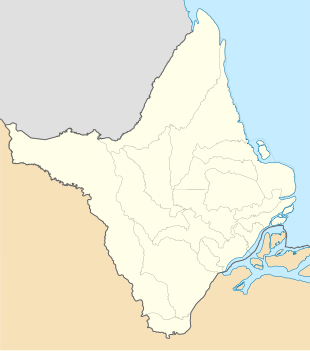| Kumarumã Santa Maria dos Galibis | |
|---|---|
  | |
| Coordinates: 3°22′44″N 51°17′59″W / 3.3789°N 51.2998°W / 3.3789; -51.2998 | |
| Country | |
| Region | North |
| State | Amapá |
| Municipality | Oiapoque |
| Government | |
| • Cacique | Paulo Roberto Silva |
| Population | |
| • Total | 2,240 |
| Time zone | UTC-3 |
Kumarumã is an Amerindian village of the Galibi Marwono people in the Brazilian municipality of Oiapoque, Amapá. It is the largest village of the tribe. Kumarumã was founded in the 1930s as Santa Maria dos Galibis. Kumarumã is located on an island in the Uaçá River in the Uaçá Indigenous Territory.
Overview
The Galibi Marworno were originally from French Guiana and lived in Jesuit missions. A Portuguese offensive in the late 18th century drove them to land inwards, where they mixed with the Arua and Marworno Amerindians. They use the self identification Galibi Marworno to distinguish themselves from the Galibis on the Oiapoque River.
In the 1930s, Santa Maria dos Galibis was established by the Indian Protection Service as means to concentrate the population. The main language of the Galibi was Karipúna French Creole. In 1934, a school was built in the village, and started to teach in Portuguese. In the late 1960s, CIMI, a Catholic organisation, started teaching Karipúna French Creole.
Kumarumã also has a clinic, and a community house. The village consisted mainly of wooden houses built on stilts, however, the younger generation has begun to build brick houses.
Kumarumã has experienced a rapid growth in the 21st century, and a large part of the island has been deforested. The economy is based on fishing and subsistence farming. The villagers are known for their canoes which they export to French Guiana.
Kumarumã can only be accessed by boat, and is located about 45 kilometres down river from the Oiapoque River.
References
- "VÍDEO: CRIANDO CORPO EM KUMARUMÃ". Padre Nello (in Portuguese). Retrieved 29 March 2021.
- "Caracterização do DSEI Amapá e Norte do Pará, conforme Edital de Chamada Pública n. 2/2017" (PDF). Ministry of Health (Brazil) (in Portuguese). Retrieved 29 March 2021.
- ^ "Galibi Marworno". Socio Ambiental. Retrieved 29 March 2021.
- ^ Anonby 2007, p. 8.
- ^ Florent Kohler (2010). "Chamanisme et politique dans l'Uaçá, Bas-Oyapock (Amapá, Brésil)". Anthropologie et Sociétés (in French). 34: 13–14.
- ^ Anonby 2007, p. 4.
- Anonby 2007, p. 9.
- "Dsei Ap Polo Base de Saúde Indigena Kumaruma - Aldeia - Oiapoque - AP - Unidade de Atenção A Saúde Indigena". Unidades de Saúde do Brasil (in Portuguese). Retrieved 29 March 2021.
- Anonby 2007, p. 17.
- Rosélis Remor de Souza Mazurek (2006). "Mapping in the Oiapoque Indigenous Territories". Revue d'ethnoécologie. 9: 27.
Bibliography
- Anonby, Stan (2007). "A report on the creoles of Amapá". Journal of Language Survey Reports.